When at or near full strength, the Detroit Lions offense has been explosive this season, averaging more than 30 points per game. So heading into Sunday, the New York Jets served as a litmus test for the unit. The combination of an outstanding defense — particularly against the pass — in chilly, outdoor conditions offered a chance for the Lions to rubber-stamp the potency of its attack.
And while one matchup doesn’t negate the overall success Detroit has had, New York largely emerged victorious in the strength-on-strength matchup, even though they fell short on the scoreboard.
The Lions scored 20 points in the win, more than 25% below their season average. But even the 20 is deceptive, since seven came from special teams — Kalif Raymond’s 47-yard punt-return touchdown — and another three were gifted by the defense after cornerback Jerry Jacobs returned an interception deep into Jets territory.
That means the Lions scored just 10 points with their remaining eight possessions. So, how did the Jets manage to do what many other opponents couldn’t, stymieing Detroit for nearly a full game? That is the focus of this week’s film study.
Red-zone woes
A significant component of Detroit’s scoring success this season has been the team’s efficiency in the red zone. Entering Sunday, no team was better at turning trips inside the 20-yard line into touchdowns. And when facing goal-to-go situations, the Lions had been unstoppable in recent weeks, converting 19 consecutive opportunities.
The Jets managed to counter both of those trends, snapping Detroit’s goal-to-go streak on the game’s opening series and holding the opposition to zero touchdowns and six points on three red-zone trips.
On the opening possession, the Lions got inside the 20 with a 12-yard pass to Amon-Ra St. Brown, where it appears quarterback Jared Goff got a little lucky, after not seeing and narrowly missing linebacker C.J. Mosley dropping into coverage.

From there, St. Brown took a handoff and caught a short pass for another first down, setting the Lions up first-and-goal from the 7-yard line. At this point, the offense appeared determined to establish control of the line of scrimmage and power it into the end zone, keeping it on the ground for four straight snaps.
Detroit opened that stretch with a zone-read look behind a pair of duo (double-team) blocks in the middle. New York’s linebackers did a nice job on the play, both with not over-committing to the threat of Goff keeping the ball and beating the blocks of the offensive line to limit Jamaal Williams to 3 yards.
The Jets beat the Lions’ duo blocks again on second down, stopping Williams after 2 yards, while the receivers and tight end Brock Wright didn’t execute on the right side of the formation on third down, resulting in Justin Jackson getting stopped short of the goal line and leaving the Lions with fourth-and-1.
Despite a prime opportunity to cap the drive with a QB sneak, the Lions instead opted for a slower-developing zone run behind two pulling tight ends. You can see on the film the sneak would have been there, to either side of center Frank Ragnow. And even though the offensive line was assignment-sound in their execution of the actual call, both tight ends failed. Rookie James Mitchell, in motion at the snap, and Wright pulling behind him, each failed to get a body on linebacker Quincy Williams, who dropped Williams for a loss and forced the turnover on downs.
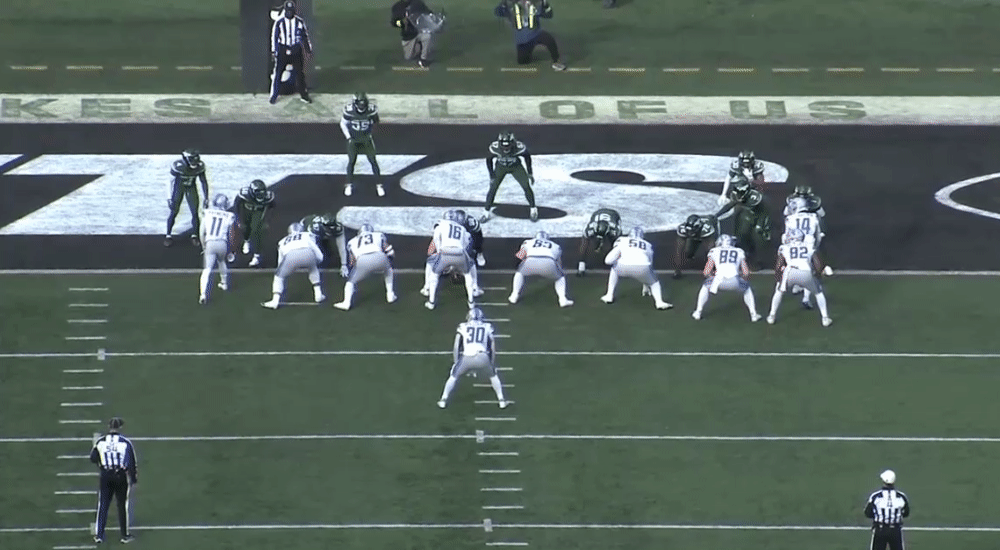
The Lions returned to the red zone in the second quarter, on the team’s third possession. It was an excellent drive, with a healthy mix of run and pass, including a well-designed fourth-down conversion in Jets territory, where coordinator Ben Johnson schemed up a pick for St. Brown out of motion.
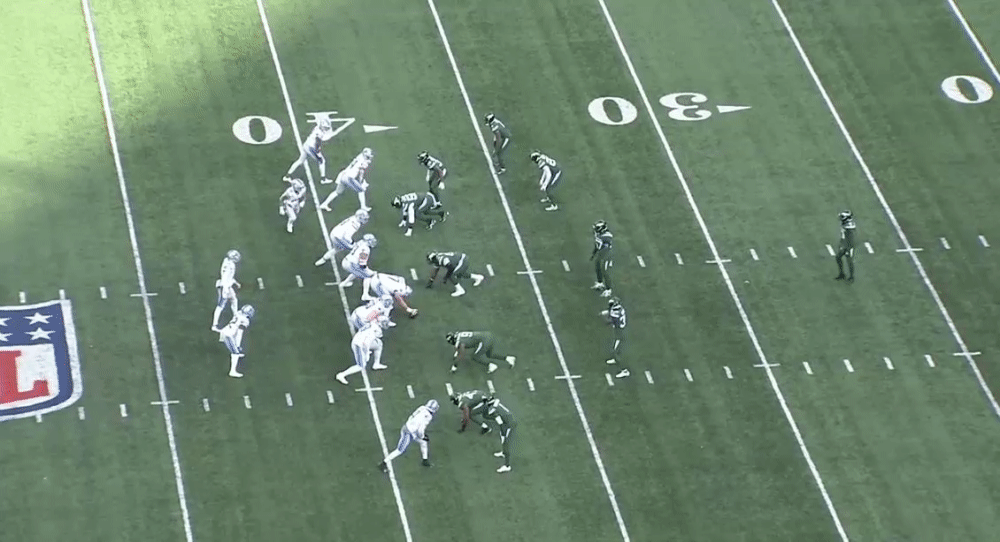
Detroit found its way inside the 20 on a check-down throw to Jackson, which the back turned into a 15-yard gain. And the offense looked to have a touchdown on the next snap, when Williams broke through the right side of his line on a counter run out of I-formation.
The back picked up excellent seal blocks from tight ends Shane Zylstra and Wright, as well as an effective lead block from fullback Jason Cabinda, but the play was negated by a holding infraction against right guard Evan Brown, who was flagged for wrapping his arm around the back of Mosley’s helmet while bringing the defender to the ground in the second level.

The Lions almost managed to climb out of that hole two snaps later on a shotgun handoff to Swift. The run’s design was solid, with Brown and Ragnow pulling ahead of the back, going right, and Wright driving the edge defender to that side past the play.
But again, Brown’s sloppy technique doomed the gain. The lineman got his hands outside the frame of cornerback Sauce Gardner, resulting in an even-more-obvious holding infraction that killed the threat of Detroit getting into the end zone.
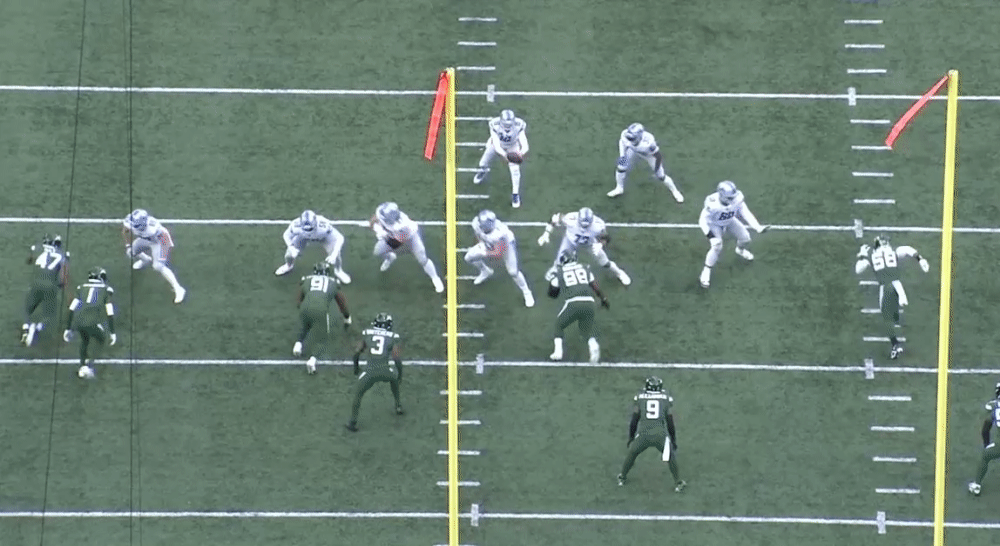
The Lions’ final trip into the red zone occurred early in the third quarter, when Jacobs’ interception set them up at the Jets’ 15-yard line.
It ended up being a short series. New York’s coverage on first down forced a check down to Swift in the left flat, which they smoothened for no gain. And on second down, a well-timed safety blitz, paired with defensive end Carl Lawson splitting the double-team blocking of Taylor Decker and Jonah Jackson resulted in Williams being stuffed for a loss.
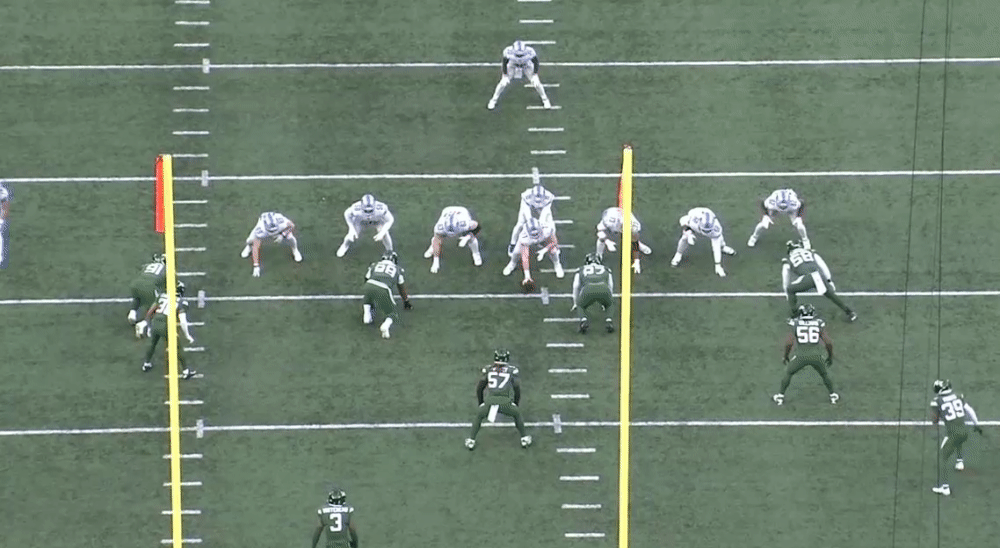
With third-and-11, the Lions tried a quick-strike slant to Raymond, hoping the receiver might be able to slip a tackle of the cornerback playing off coverage, but Goff misfired, putting the ball behind his receiver. The incompletion left the Lions to settle for a short field goal.
Lack of explosives
A year ago, the Jets were one of the worst defenses in the NFL, particularly when it came to surrendering explosive pass plays. In 2021, they allowed 73 completions of 20 or more yards, which ranked 31st in the NFL. This year, through 14 games, they’ve given up 30 such gains, behind only Dallas (28) and New Orleans (29).
What’s changed? Well, you can never dismiss the value of a second year in a system with proven coaching, but they also made major personnel upgrades, led by first-round draft pick Sauce Gardner and free-agent addition D.J. Reed.
And yes, the Lions didn’t throw Gardner’s way once. They tried, on several occasions, but every time the read progression called for Goff to look that direction, the rookie had his coverage responsibility on lock. He was as impressive as advertised.
The overall stinginess of the secondary also showed up against the Lions, in a game where the team’s longest pass play was 18 yards through the first 65 snaps, before a forced coverage bust on the final offensive snap resulted in Wright’s 51-yard, game-winning score.
The Jets mixed up their coverages well, playing a combination of Cover-1 man and Cover-2, Cover-3 and Cover-4 zones. Where they thrive, compared to many defenses we see on tape, is their discipline matching and passing off receivers in the underneath zones.
Goff didn’t attempt many downfield throws, simply because he almost never had an option open. Even in situations where he looked to have a window, a defender or two were drifting toward the passing lane, making those throws higher risk in a game where the Lions could little afford a turnover.
The Jets also showed tremendous discipline on play-action, which is an area where the Lions are frequently able to exploit an opponent. By not overcommitting to Detroit’s run fakes, the defense was able to quickly get to their zone drops, where, as previously mentioned, they showed consistent execution with their coverage matching.
Prior to Wright’s late touchdown, the Lions did have one opportunity to beat the Jets for an explosive gain. Running a trio of vertical routes into the teeth of what appears to be a quarters defense, Wright and Chark occupied the attention of the middle-field safeties, leaving Jameson Williams one-on-one with cornerback D.J. Reed on the left side.
Williams does a nice job getting separation on a skinny post, even utilizing a slight push-off at the top of the route. Goff has eyes on the rookie from the snap and is able to step up in a clean pocket to deliver the deep ball, but it comes up a couple of yards short, allowing Reed to recover for the PBU. After the game, Goff said he should have thrown the ball sooner, which could have helped, but regardless, it was a blown opportunity against an opponent who rarely offered them.
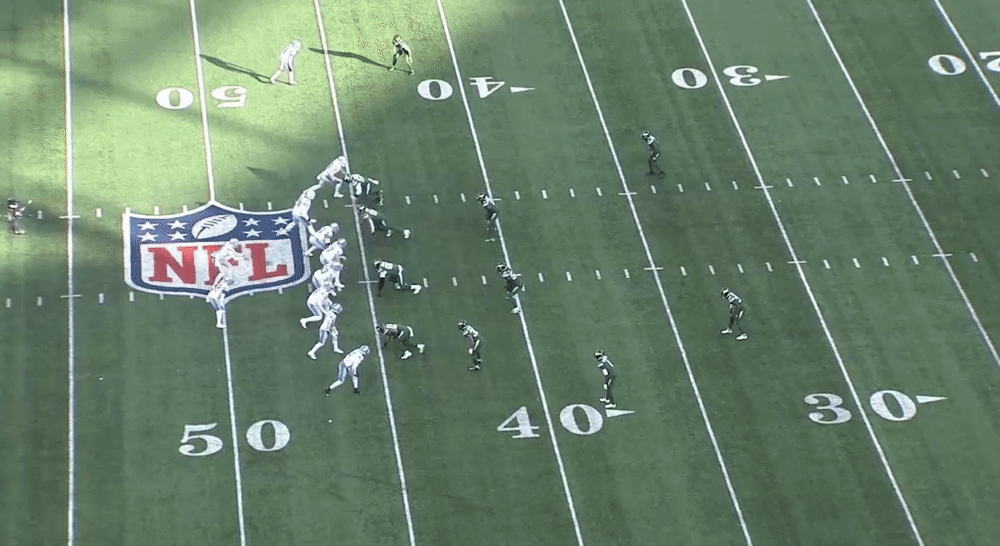
Self-inflicted wounds
Playing bend-don’t-break defense, the Jets count on their opposition to make mistakes, whether it’s a dropped pass, a blown block or a penalty. Within their struggles on the day, the Lions obliged.
We already noted the blown blocks on fourth-and-goal to start the game, and Brown’s two holds that negated a touchdown in the second quarter. Those miscues resulted in missing out on 11 points (one field goal instead of a possible two touchdowns). Goff’s errant third-down throw to Raymond also fits, although that play had less than a 50% chance of converting, even if the pass were on target.
Elsewhere in the game, Ragnow committed a hold that offset the Jets jumping offside. Without that hold, the Lions have third-and-1 at the Jets’ 31. Instead, the offsetting penalties left it third-and-6. The Lions throw an incompletion there and are forced to try a 54-yard field goal that was missed. All things equal, kicker Michael Badgley had the distance to make it from 49 yards.
Or how about on the game’s second series, when Goff made a good read through his progressions on third down, dumping it off to Jackson in space, but the back dropped the ball? Not that it mattered, since Penei Sewell was also flagged for holding on the play.
It’s never going to be perfect, but the Lions definitely left plenty of points on the field through execution errors. If you’re not getting explosives, you simply have to be more disciplined.
Just-in-time breakthrough
With the game at risk of slipping away, the Lions did make the one play needed to put them over the top. It certainly wasn’t designed to go for 50 yards, but coach Dan Campbell acknowledged after the game the team felt the fourth-down call had potential to generate an explosive pickup.
The execution on the game-winning touchdown was excellent, across the board. In a condensed formation on the fourth-and-inches play, Goff’s first read was St. Brown, who motioned through the backfield on the snap into the right flat, but was picked up through a late, well-communicated coverage switch by the Jets.
The Lions sold a handoff to Jackson, while the back did an outstanding job coming out of the play fake and cutting down safety Jordan Whitehead at the line of scrimmage, which also redirected the rush of the linebacker, buying Goff more time.
Wright, lined up off right tackle and initially worked a combo block with Sewell, further selling the run, before breaking off the block, not to pick up a linebacker in the second level, but rather run a crossing route into open space on the left side.
The reason there was so much green ahead of Wright after the catch was part of the play’s design. Not only did St. Brown’s pre-snap motion draw a defender away, but the remaining receiver to that side, Chark, ran an in-breaking vertical route that commanded the attention of the remaining Jets defender.
Wright did the rest, outrunning nickel cornerback Michael Carter II, the man originally covering St. Brown, before cutting inside and utilizing Josh Reynolds to avoid safety Will Parks.
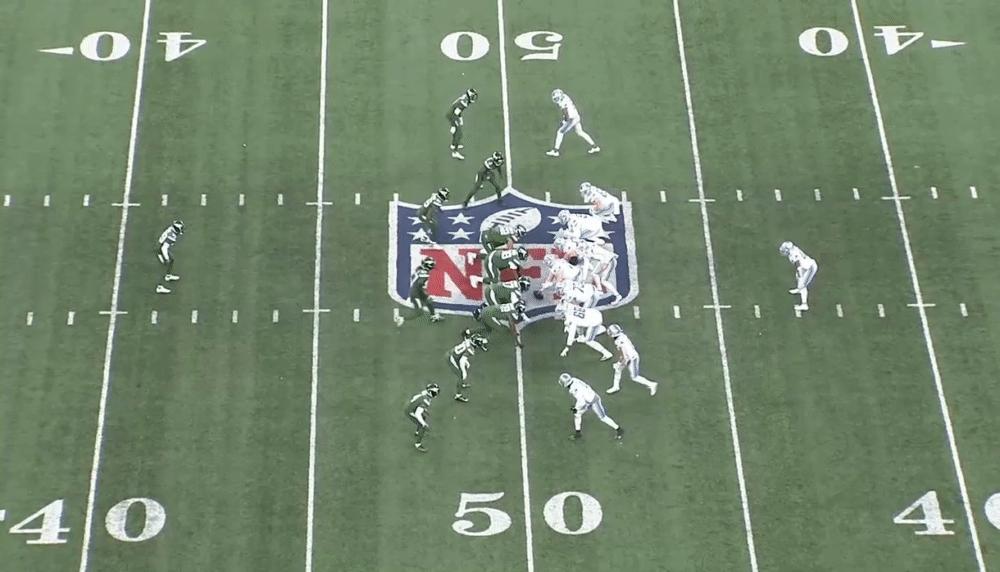
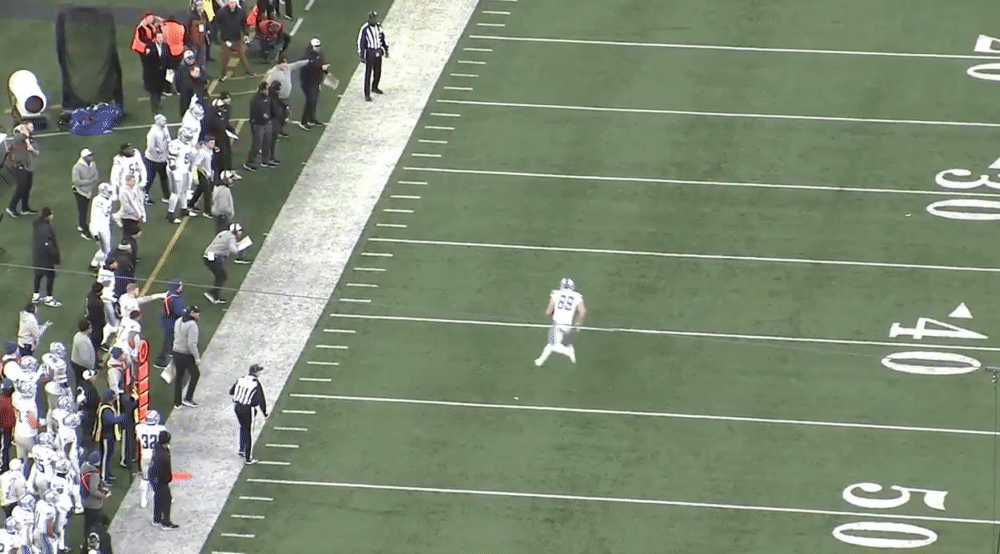
jdrogers@detroitnews.com
Twitter: @Justin_Rogers